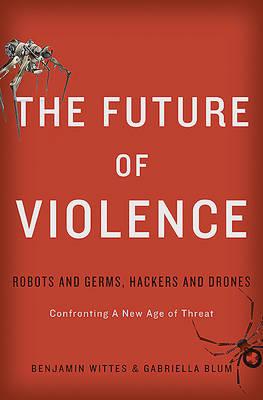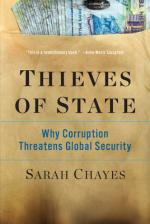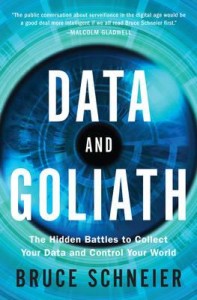The Future of Violence: Robots and Germs, Hackers and Drones, Confronting A New Age of Threat, by security experts Benjamin Wittes and Gabriella Blum of the Brookings Institute and Harvard University Law School respectively, brings the reader into a very Brave New World. With the creation of everything from microdot surveillance instruments to swarm cameras to insect sized flying robotic weapons to viruses which can be manipulated by ordinary citizens and unleashed on entire cities to goggles, due to be commercialized by the end of 2015, which will allow an individual to be able to see in real time what is happening anywhere from the top of Mount Everest to Times Square, the future has already arrived. That in an era where a medieval-style holy war is also raging, the potential dangers of the rapid evolution of technology are all too painfully evident. Wittes and Blum begin their introduction to The Future of Violence with the scenario of a robotic drone spreading anthrax. But there are even more frightening scenarios: “We built walls around our countries with legal concepts such as jurisdiction. And for the most part, these intellectual, conceptual and legal constructions have held up pretty well. Yes, we had to adjust in response to al-Qaeda and other transnational nonstate actors. And yes, globalization has complicated the discussion. But the way we think about security–what it means, where it comes from, what threatens it, what protects it, and the relationship between individual and societal security–has remained remarkably stable… This way of thinking is now out of date… The fabric of society and its governance is based on dated assumptions about a technological world that no longer exists.”
As the highly accomplished journalist Graeme Wood wrote in his excellent piece in The Atlantic What ISIS Really Wants, and following principles of excommunication known as takfiri, Islamic State is committed to purifying the world by killing vast numbers of people. They believe they are the principal agents for a coming apocalypse, the so-called End of Days first prophesied in Islamic texts 1400 years ago. That the agents for mass slaughter are now increasingly at hand, as revealed in The Future of Violence, dramatically escalates the threat faced by unbelievers in the West.
Muslims acknowledge that God is the only one who knows the future. But they also agree that he has offered us a peek at it, in the Koran and in narrations of the Prophet. The Islamic State differs from nearly every other current jihadist movement in believing that it is written into God’s script as a central character. It is in this casting that theIslamic State is most boldly distinctive from its predecessors, and clearest in the religious nature of its mission. In broad strokes, al-Qaeda acts like an underground political movement, with worldly goals in sight at all times—the expulsion of non Muslims from the Arabian peninsula, the abolition of the state of Israel, the end of support for dictatorships in Muslim lands. The Islamic State has its share of worldly concerns (including, in the places it controls, collecting garbage and keeping the water running), but the End of Days is a leitmotif of its propaganda.
As Wood wrote: “Islamic State is no mere collection of psychopaths. It is a religious group with carefully considered beliefs, among them that it is a key agent in the coming apocalypse. The lack of objective reporting from its territory makes the true extent of the slaughter unknowable, but social-media posts from the region suggest that individual executions happen more or less continually, and mass executions every few weeks…
This was the group that the American President had dismissed as a minor baseball team, and the Prime Minister of Australia had described as a “death cult”. They were either stupid, incompetent, or deceitful, deliberately deluding their citizens as to the nature of the threat they faced.
That the agents for mass slaughter were now increasingly at hand, as revealed in the recent book The Future of Violence, dramatically escalated the threat faced by unbelievers in the West.
Islamic State rejects peace as a matter of principle; hungers for genocide; its religious views make it constitutionally incapable of certain types of change, even if that change might ensure its survival; and it considers itself a harbinger of—and headline player in—the imminent end of the world.
Politicians on both sides of the House had for years been deceiving the Australian public about the threat it faced
Barack Obama, Tony Abbott and numerous other politicians across the Western world, in an effort to calm ethnic tensions which would never be calmed, had claimed the group was un-Islamic. It was an utterly misinformed claim which led to serious strategic errors.
As Wood observes, the beheadings, the slavery, the crucifixions, the subjection of Jews and Christians, all were part of a medieval Islamic tradition. The laws of war passed down in the Koran and in the narrations of the Prophet’s rule were calibrated to fit a violent and turbulent time. The fighters of Islamic State are authentic throwbacks to early Islam and are faithfully reproducing its norms of war.
As Wood wrote: “The reality is that the Islamic State is Islamic. Very Islamic. Yes, it has attracted psychopaths andadventure seekers, drawn largely from the disaffected populations of the Middle East and Europe. But the religion preached by its most ardent followers derives from coherent and even learned interpretations of Islam.
“Virtually every major decision and law promulgated by the Islamic State adheres to what it calls, in its press and pronouncements, and on its billboards, license plates, stationery, and coins, ‘the Prophetic methodology,’ which means following the prophecy and example of Muhammad, in punctilious detail. Muslims can reject the Islamic State; nearly all do. But pretending that it isn’t actually a religious, millenarian group, with theology that must be understood to be combated, has already led the United States to underestimate it and back foolish schemes to counter it. We’ll need to get acquainted with the Islamic State’s intellectual genealogy if we are to react in a way that will not strengthen it, but instead help it self-immolate in its own excessive zeal.”
Tens of thousands of foreign Muslims are thought to have immigrated to the Islamic State. Recruits hail from France, the United Kingdom, Belgium, Germany, Holland, Australia, Indonesia, the United States, and many other places. Many have come to fight, and many intend to die.
From drone warfare in the Middle East to digital spying by the National Security Agency, the U.S. government has harnessed the power of cutting-edge technology to awful effect. But what happens when ordinary people have the same tools at their fingertips? Advances in cybertechnology, biotechnology, and robotics mean that more people than ever before have access to potentially dangerous technologies from drones to computer networks and biological agents which could be used to attack states and private citizens alike.
The Future of Violence details the myriad risks present in the modern world and argue that if our national governments can no longer adequately protect us from harm they will lose their legitimacy.
Consequently, governments, companies, and citizens must rethink their security efforts to protect lives and liberty. In this where many little brothers are as menacing as any Big Brother, safeguarding our liberty and privacy may require strong domestic and international surveillance and regulatory controls. Maintaining security in this world where anyone can attack anyone requires a global perspective, with more multinational forces and greater action to protect (and protect against) weaker states who do not yet have the capability to police their own people.
Drawing on political thinkers from Thomas Hobbes to the Founders and beyond, Wittes and Blum show that, despite recent protestations to the contrary, security and liberty are mutually supportive, and that we must embrace one to ensure the other.
The Future of Violence is at once an introduction to our emerging world, one in which students can print guns with 3-D printers and scientists’ manipulations of viruses can be recreated and unleashed by ordinary people and an authoritative blueprint for how government must adapt in order to survive and protect us.
With the creation of everything from microdot surveillance instruments to swarm cameras to insect sized flying robotic weapons to viruses which can be manipulated by ordinary citizens and unleashed on entire cities to goggles, due to be commercialized by the end of 2015, which will allow an individual to be able to see in real time what is happening anywhere from the top of Mount Everest to Times Square, the future has already arrived.That in an era where a medieval-style holy war is also raging, the potential dangers of the rapid evolution of technology are all too painfully evident. Wittes and Blum begin their introduction to The Future of Violence with the scenario of a robotic drone spreading anthrax. But there were even more frightening scenarios: “We built walls around our countries with legal concepts such as jurisdiction. And for the most part, these intellectual, conceptual and legal constructions have held up pretty well. Yes, we had to adjust in response to al-Qaeda and other transnational nonstate actors. And yes, globalization has complicated the discussion. But the way we think about security–what it means, where it comes from, what threatens it, what protects it, and the relationship between individual and societal security–has remained remarkably stable… This way of thinking is now out of date… The fabric of society and its governance is based on dated assumptions about a technological world that no longer exists.
“In our new world you, can pose a threat to the security of every state and person on the planet–and each can also threaten you. In our new world, individuals, companies, and small groups have remarkable capabilities either to protect others or to make them more vulnerable. In our new world, not only do privacy and security not generally conflict, but they are often largely the same thing. And in our new world, state power represents a critical line of defense for individual freedom and privacy, even as the state itself may be losing its ability to serve its purpose as the ultimate guarantor of security to its citizens.
“Driving this new environment is a mix of technological developments. There is the radical proliferation of data about individuals and technologies of mass empowerment available to individuals. Notwithstanding Edward Snowden’s spectacular revelations about the National Security Agency (NSA), the state’s comparative advantage in collecting data, manipulating it and, and exposing individuals to risks or protecting them from threats is actually eroding, even as bigger companies occupying ever more powerful market positions take on data collection and analytics as their business cores. The miniaturization and automation of weapons further weakens national boundaries–as well as the front door to your house–as effective lines of defense. Biological research and biological technology are new modes of attack. As these technologies become cheaper, more and more people have the ability to give expression to what resides in their hearts in the digital world, in the physical world, and in the microscopic coding of life itself. And as these technologies get cheaper, we become, as a global community, ever more dependent on them for our health, agriculture, communications, jobs, economic growth and development, and even our culture…
“Governments must contemplate the possibility of ever smaller groups of people undertaking what has are traditionally understood as acts of war. The past few decades have seen an augmenting ability among relatively small, nonstate groups to wage asymmetric conflicts against even powerful states. The groups in question have been growing smaller, more diffuse, and more loosely knit, and technology is both facilitating that development and increasing these groups’ ultimate lethality. The trend…ultimately threatens to give every individual with a modest education and a certain level of technical proficiency the power to wreck potentially catastrophic damage.
‘As a thought experiment,” write Wittes and Blum, “imagine a world composed of billions of people walking around with nuclear weapons in their pockets.” The Wall Street Journal observed: “If such an exercise doesn’t strike you as bonkers, then I’ve got an enthusiastic book recommendation for you. Sadly for the rest of us, the fear-mongering in “The Future of Violence” is no laughing matter but rather a depressingly accurate summation of how centrist Washington has come to view the democratization of technology: with a distrust bordering on panic.”







